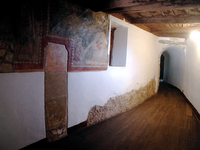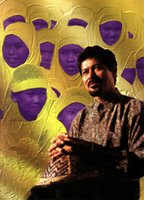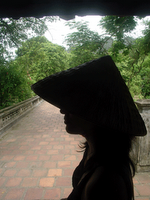
THE VEIN OF THIRTY-FOUR YEARS
RENATO REDENTOR CONSTANTINO
ParasIndonesia
September 11, 2006
Turbulence framed his horizon and the young writer wrote it all down. Visage and facade, noise and speech. He drew anger and desire and with words pushed history to quicken its footstep.
"Thunder of feet, tumult of images and sounds," scribbled the writer of the clash of January 26, when discontent collided with the conceit of power, and everywhere the disparate sounds of footfall: clatter of blustering protest, cadenced menace of pursuing boots, and the louder, unmistakable canter of nervous indifference.
 The year was 1970 and the sounds of the epoch largely sketched the mood of the nation. Perhaps the sounds resonate still.
The year was 1970 and the sounds of the epoch largely sketched the mood of the nation. Perhaps the sounds resonate still."White smooth round crash helmets advancing like a fleet of flying saucers in the growing darkness," wrote Jose F. Lacaba, then a young journalist, in prose that allowed generations to "see the faces ... hear the voices" -- to smell the mood. "The tread of marching feet, the rat-tat-tat of fearful feet on the run, the shuffle of hesitant feet unable to decide whether to stand fast or flee.... And everywhere a confusion of shouts
Two years after, the eminent Senator Pepe Diokno would speak about the imminence of martial rule at a gathering of intellectuals and explain why, if the judiciary fell to pieces, he would be left with no other option but "to take up the gun and go to the hills with the activists."
 The late professor Dolores Stephens Feria recalled running into Nur Misuari at the faculty center of the University of the Philippines. It was the middle of July 1972 and Misuari had just come from Cotabato. "They are murdering hundreds of our Muslim people daily through death squads and arresting even more without warrants," said Misuari, who shared to Feria the shape that his life had taken and how he had decided to speak openly in the marketplace and urge his Muslim countrymen to arm themselves. "I only came back to the university to formally resign and turn in some old grades for my students," said Misuari, who would eventually become a beacon of resistance,
The late professor Dolores Stephens Feria recalled running into Nur Misuari at the faculty center of the University of the Philippines. It was the middle of July 1972 and Misuari had just come from Cotabato. "They are murdering hundreds of our Muslim people daily through death squads and arresting even more without warrants," said Misuari, who shared to Feria the shape that his life had taken and how he had decided to speak openly in the marketplace and urge his Muslim countrymen to arm themselves. "I only came back to the university to formally resign and turn in some old grades for my students," said Misuari, who would eventually become a beacon of resistance,  Months later, on September 21, 1972 Ferdinand Marcos declares martial law and the American Chamber of Commerce cheers the open display of the iron fist. Scores go underground or flock to the hills while others such as Diokno take the equally epic route of confronting the dictatorship openly. Each course was a recourse of solidarity. To defend the rights of others. To give refuge to the hunted. To mourn the fallen and to embrace the faltering. To stand with others. To write with unambiguous honesty, as Pete Daroy once explained, at a time when telling the truth, especially through writing, "had become a historical and moral -- even genetic -- responsibility."
Months later, on September 21, 1972 Ferdinand Marcos declares martial law and the American Chamber of Commerce cheers the open display of the iron fist. Scores go underground or flock to the hills while others such as Diokno take the equally epic route of confronting the dictatorship openly. Each course was a recourse of solidarity. To defend the rights of others. To give refuge to the hunted. To mourn the fallen and to embrace the faltering. To stand with others. To write with unambiguous honesty, as Pete Daroy once explained, at a time when telling the truth, especially through writing, "had become a historical and moral -- even genetic -- responsibility." The best and the brightest are mown down by the dictatorship. Lorena Barros. Edgar Jopson. Eman Lacaba. Leticia Ladlad. A fistful of names among martyred nameless multitudes. "We are tribeless and all tribes are ours," wrote Eman Lacaba in a poem he penned in 1976, months before he was murdered. "We are homeless and all homes are ours. / We are nameless and all names are ours."
Thirty-four years ago the country bled for fourteen years. And then some.
But we are such a forgetful people.
 Lured once more by blustering promises of affluence and the so-called material comforts of the iron order, too many today feign disinterest despite the festering disquiet, convinced again, perhaps, that they can inhabit the ennui of the spectator with little disruption to their lives.
Lured once more by blustering promises of affluence and the so-called material comforts of the iron order, too many today feign disinterest despite the festering disquiet, convinced again, perhaps, that they can inhabit the ennui of the spectator with little disruption to their lives.The big lie lives.
Here is the comfort today: Filipino care -- mothers, sisters, nurses, doctors and teachers -- boxed and flown to other countries while the caregivers' children are left behind to be nourished by neglect or, if the young ones are lucky, to be nurtured by decrepit hospitals, dilapidated schools and disintegrating families.
Here is the care: butchers propping up an illegitimate administration have set up shop in the presidential palace and in whole provinces; they refuse to leave. Today, dissenters are slaughtered again like chickens. Mission orders are sent out by the military to slay members of the clergy, members of political parties, young activists, students, lawyers, labor leaders, farmers. Elected officials. Journalists.
 No door of restraint is left unhinged and no family is left unscrewed, save for a handful among the old landed clans and the total handful of the rapacious new oligarchy. And as it was before, so it is today -- the price of unconcern remains the same -- things have not gotten better; things have become worse.
No door of restraint is left unhinged and no family is left unscrewed, save for a handful among the old landed clans and the total handful of the rapacious new oligarchy. And as it was before, so it is today -- the price of unconcern remains the same -- things have not gotten better; things have become worse."A typhoon approaches quietly, massive and grey," wrote the Filipino fictionist Eric Gamalinda in his 1992 novel The Empire of Memory, which tells the story of a Marcosian-like era long gone. And yet, the novel seems to be telling us about today. For a long time in the land of dreams, Gamalinda tells us, "Thunder rumbles but always seems too distant to cause alarm. And as always, everything is caught by surprise: the sky darkens immediately, like ink in water, and the rains begin to pour in unrelenting torrents, as if someone had ripped the sky open and drained enormous oceans out of it."
 Maybe it is really as Gamalinda wrote, that ours is indeed "a land both fact and fiction, where generations leave no trace of themselves and everything is constantly wiped out by clockwork destruction: typhoon, tsunami, earthquake, drought." Even martial rule. "We have no memory of ourselves," Gamalinda notes. "[W]e remember only the last deluge, the last seismic upheaval." Then new pain inundates the land and the last calamity is again forgotten.
Maybe it is really as Gamalinda wrote, that ours is indeed "a land both fact and fiction, where generations leave no trace of themselves and everything is constantly wiped out by clockwork destruction: typhoon, tsunami, earthquake, drought." Even martial rule. "We have no memory of ourselves," Gamalinda notes. "[W]e remember only the last deluge, the last seismic upheaval." Then new pain inundates the land and the last calamity is again forgotten.If the bane of the past is forgetting, what is the vein of the present?
Thirty-four years ago we bled for fourteen years. We bleed still. #
NOTES:
1. Jose F. Lacaba, Days of Disquiet, Nights of Rage (Salinlahi Publishing House, Manila: 1982).
2. Ibid. From the book's foreword by Quijano de Manila.
3. Dolores Stephens Feria, Project Sea Hawk: The Barbed Wire Journal (Paper Tigers and Circle Publications: 1993).
4. Ibid. Nur Misuari headed the Moro National Liberation Front (MNLF), which led the fight against the Marcos dictatorship's drive to crush the aspirations of the Bangsamoro people for self-determination and independence. Though embroiled in a spate of recent political controversies arising out of ill-advised political decisions, Misuari remains a national figure and a respected icon even among young activists struggling for self-determination and the full emancipation of the Bangsamoro people. Learn more about the struggle of the Bangsamoro people via http://www.bangsamoro.com
5. Ibid.
6. Rina Jimenez-David, "Remembering the disappeared," Philippine Daily Inquirer, 10 June 2006. Over 1,600 people were "disappeared" in The Philippines during the Marcos dictatorship and since. None of them have been found. See the website of Families of Victims of Involuntary Disappearances (FIND), the distinguished Philippine organization leading the campaign against injustice and to keep the memory of the disappeared alive. See: http://www.desaparecidos.org/find/. See also the website of Project Disappeared: http://www.desaparecidos.org/phil/eng.html
7. From the harrowing and inspiring book Six Young Filipino Martyrs, edited by Asuncion David Maramba (Anvil Publishing, Inc.: 1997). The book tells the stories of six young heroes, Lean Alejandro, Edgar Jopson, Maria Lorena Barros, Abraham Sarmiento, Bobby de la Paz and Eman Lacaba, who is the brother of Jose "Pete" Lacaba, a poet of great power.
8. The number of politically motivated killings of activists since Arroyo took power in 2001 to the present ranges from a low of 247 to a high of 700. For more background, see the Promdi web log entries of journalist Carlos H. Conde, "Expect more political killings," July 25, 2006 and "Daily carnage," (from Conde's interview of Amnesty International Philippines executive director Jessica Soto), August 1, 2006. There are a variety of recent sources confirming that the murder of dissidents has become official state policy. See Lira Dalangin-Fernandez, "Arroyo censures murders, praises Palparan," Philippine Daily Inquirer, July 24, 2006; Christian V. Esguerra, "Probers tag soldiers in Albay pastor's murder," Philippine Daily Inquirer, August 31, 2006; Seth Mydans, "Rights groups say military behind killings," International Herald Tribune, August 25, 2006; "Political killings, Human Rights and the Peace Process," Amnesty International bulletin, August 15, 2006. See: http://web.amnesty.org/library/Index/ENGASA350062006. See also "Urgent Appeal: Family members of slain church worker faces security risk," Asian Human Rights Commission, August 18, 2006. For background on the menace faced by Filipino journalists today, see Donald Kirk, "Filipino journalists bite the bullet," Asia Times, 27 June 2006. See: http://www.atimes.com/atimes/Southeast_Asia/HF27Ae01.html.
9. Eric Gamalinda, The Empire of Memory (Anvil Publishing, Inc: 1992)
10. Ibid.
All photos taken by the author unless otherwise indicated . 1) Photo of a well-preserved painting of a young Ferdinand Marcos, which Red discovered to his surprise leaning on a wall on the second floor of the museum of Jolo (March 2006). 2. A corridor in the monastery that St. Francis was said to have built with his own hands in Greccio, Italy (June 2006). 3. Misuari's photo is from an article published in the former AsiaWeek. To access the article, click here. 4. Kala in Hanoi, Vietnam (July 2006). 5. Another passageway in the monastery of St. Francis (June 2006). 6. Fully armed, battle-uniformed former MNLF fighters and now Philippine National Police Special Forces regulars escorting delegates to the centennial commemoration of the Bud Dahu massacre (March 2006). 7. Negative image of a very beautiful three dimensional Guernica-themed exhibit at the Ho Chi Minh museum in Hanoi, Vietnam (July 2006).
BACK TO RED's MAIN PAGE
No comments:
Post a Comment